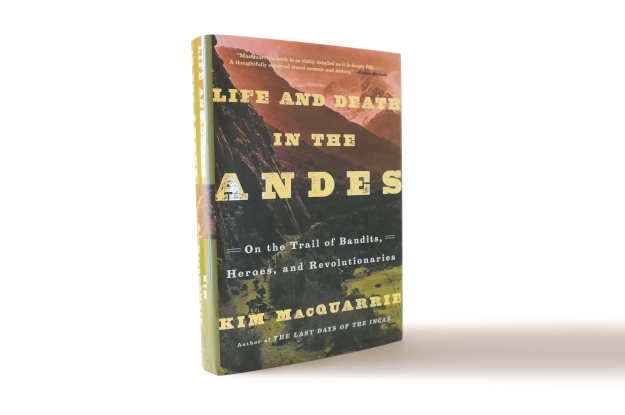In Life and Death in the Andes (Simon & Schuster), award-winning filmmaker and best-selling author Kim MacQuarrie journeys through 2,500 miles of vertical landscape – and 10,000 years of history – to reveal the heart and soul of a long-troubled and neglected part of the world.
Told through a series of major events that read almost like detective stories – from the killing of Che Guevara in the Bolivian jungle to the amazing tale of an Amazonian woman of the Yamana tribe who perished under mysterious circumstances in Patagonia – MacQuarrie uses his tale to adroitly illuminate the Andean past and the environment and geography from which it springs.
Along the way, he explores theories about the origins of human settlement in the region, the rise of the Inca Empire and the epic of Spanish Conquest. Throughout, he looks at the resulting racial and cultural mix that has come to define the ethnic composition of the countries that straddle the mountain chain — from Venezuela, Bolivia and Colombia in the north to Argentina and Chile in the south.
The book opens with a look at the life and death of Pablo Escobar, the former drug-trafficking king of Colombia. But MacQuarrie links the story to a much older theme of the region: the search for El Dorado. Indeed, though he returns repeatedly to the region’s troubled recent past, MacQuarrie makes clear that murder and mystery in the Andes did not begin with the modern era. No story better typifyies the author’s method than that of the so-called Ice Maiden of Ampato – the mummy of an Incan girl also dubbed “Juanita.” MacQuarrie creates what he calls “an imaginative reconstruction, based on the historical, ethnographic, forensic and archeological record,” to tell the story of the girl whose life ended brutally in the late 1400s on Mount Ampato in what is now Southern Peru.
The past is never quite over in these retellings, and Juanita’s story doesn’t end with her ritual death but rather with the discovery 500 years later of her frozen body, wrapped in an alpaca-wool burial bundle, by American archeologist Johan Reinhard.
Visiting the girl’s mummified remains, now encased in a large glass cubicle in a university museum in the Peruvian city of Arequipa, MacQuarrie writes, “I can make out the outlines of an Inca girl, still covered in a finely woven tunic and shawl, her hair coiffed in an almost Gorgon’s coil of finely woven black braids … crouching in a position she has remained in for half a millennium.”
Such indelible images, combined with a sparkling narrative style and masterful historical investigation, make MacQuarrie’s effort to compress 10,000 years of Andean into a single volume a delight to read.
—
Klaren is professor of history and international affairs at The George Washington unvirsity and author of Peru: Society and Nationhood in the Andes (Oxford University Press, 2000).



